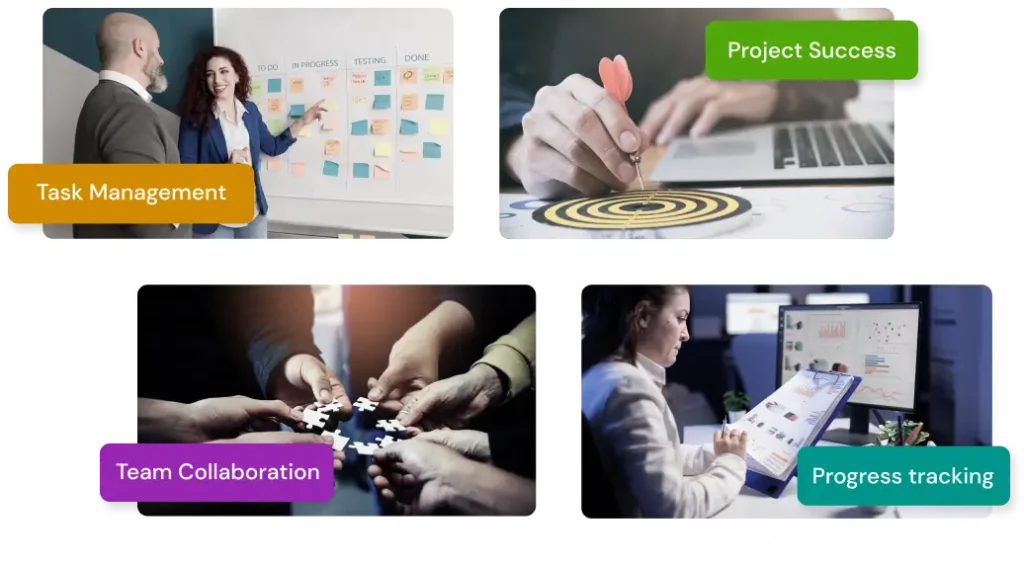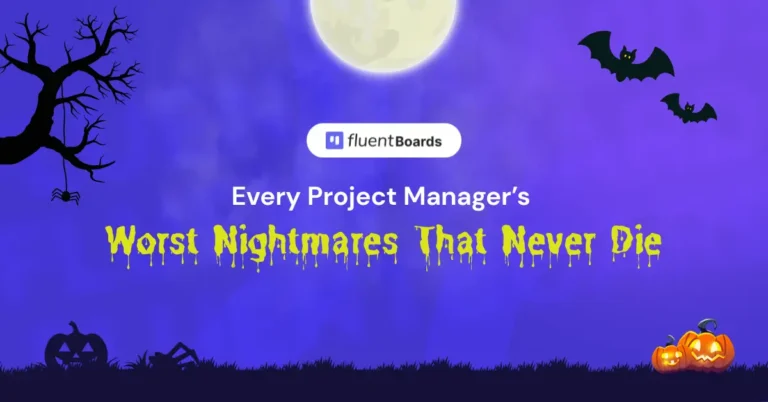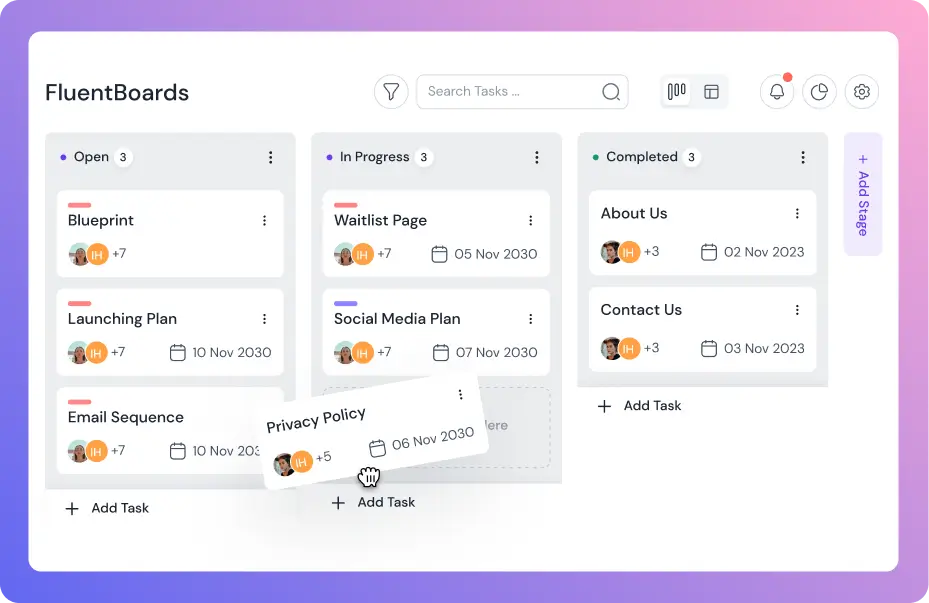
Project Manager Explained: The Driving Role Behind Every Successful Project
There’s a massive project on the table. It’ll take months to finish, dozens of people to coordinate, and huge resources to manage.
Without someone managing it?
The whole thing falls apart. Or at the very least, takes way longer and rarely deliver what they promised.
So, who do you look to when you find a situation like this?
Project Managers.
This guide breaks down everything you need to know about project managers: their role, responsibilities, skills, and impact on project success.
Let’s dive in!
What is Project Management?
Before we start with project managers, let’s quickly understand what project management actually is.
Project management is the process of planning, organizing, and overseeing projects to achieve specific goals within a defined timeline and budget.
In short, we can say that a project is any action that, once taken, changes your project current state to a new state throughout the project management lifecycle:

- Initiation
- Planning
- Execution
- Monitoring
- Closure
At each stage, someone needs to do exactly what the title says: “manage projects”.
Well, that’s where the project manager steps in.
Also Read: Why is Project Management Important
What is a Project Manager?
A project manager is a goal-oriented person responsible for leading projects from start to finish, ensuring they stay on time, within scope, on budget, and meet quality standards.
In a literal sense, they plan, organize, manage resources, and guide projects through every phase of the project lifecycle.
At the same time, they align daily work with broader company goals, making sure every task moves the project forward.
This makes them the central figure who:
- Map out timelines and coordinate tasks across teams
- Solve problems and adjust plans when things go sideways
- Communicate progress to leadership and stakeholders
- Make critical decisions and handle obstacles
Ultimately, they have one goal: deliver successful outcomes that make an impact.

Level up your WordPress project management game with this Trello equivalent solution – where limitless possibilities come at an unbeatable price!
How Project Managers Differ from Other Key Roles
Here’s how project managers differ from other roles that often get confused in the management world.
Project manager vs. a Program manager
Both roles aim for successful project delivery but take different paths to get there. Product managers define the “what” and “why,” while project managers handle the “how” and “when.”
Below are the key differences between these two roles:
| Aspect | Product manager | Project manager |
| Role | Oversees product needs from development to release | Manages project execution from task assignment to delivery |
| Focus | Product vision and strategy | Execution and coordination |
| Key tasks | Collect data, build product roadmaps, determine launch priorities | Manage a project team, define KPIs, allocate project resources |
| Success measures | Address product failures, secure materials, achieve revenue targets | Maintain team communication, monitor risks, deliver business results |
Project manager vs. a Program manager
At first, these roles sound similar since both lead teams. However, their responsibilities differ greatly: project managers deliver single projects, while program managers oversee multiple ones to achieve long-term strategic objectives.
The key distinction comes down to:
- Scope
- Degree of complexity
Here are the key differences between these two roles:
| Aspect | Program manager | Project manager |
| Role | Oversees multiple projects and ensures strategic alignment | Leads individual projects from start to completion |
| Focus | Long-term strategy and program-level planning | Work coordination and task execution |
| Duration | Long-Term | Short-Term |
| Key tasks | Strategy execution, cross-team alignment, and success metric setting | Organize projects, coordinate work, and ensure progress stays on track |
| Success metrics | Measured by program success, ROI, and organizational objectives | On-time completion, budget control, and quality delivery |
Project Manager Responsibilities: What They Do Across the Project Lifecycle
Project managers wear many hats to keep projects healthy and moving forward. They fill in gaps, solve problems as they arise, and act as the glue holding teams and stakeholders together.
As the Project Management Institute (PMI) explains-
Project managers are change agents who take ownership of project goals and create a shared sense of purpose across the team.
Usually, their responsibilities unfold across five key phases of the project lifecycle.
Let’s break down what they do at each stage.
The project initiation phase and the project manager
Project management begins with the initiation phase.
This is the very first stage, where organizations give the green light and say, “Yes, let’s make this happen.”
The moment a project gets approved and a project manager is assigned, their job officially begins.
Their first order of business? Communication and clarity.
They sit down with their seniors to discuss expectations, objectives, and constraints, then move to the next crucial step: identifying stakeholders.
Now, you might be wondering: who exactly are stakeholders?
Well, stakeholders are anyone with a vested interest in the project’s success or outcome. This could include:
- Internal teams
- External parties
The project manager brings these voices in early, keeps them informed, and ensures their concerns are heard before diving into project details.
This includes understanding:
- Project goal: What’s the high-level outcome we want to achieve?
- Project objectives: What specific, measurable results will get us there?
- Project Scope: What’s included, and just as importantly, what’s excluded?
- Resources: What budget, tools, and team members are available?
- Expectations: What does success look like for everyone involved?
- Constraints: What are the deadlines, limitations, and potential roadblocks?
They also review past similar projects. This way, they learn what worked and how to avoid repeating mistakes.
By the end of this phase, the project manager transforms vague approval into a clear foundation everyone can follow with confidence.
Need more details on getting this phase right? Check out our full guide: Project Initiation Phase 101
The project planning phase and the project manager
Once the initiation phase wraps up, the real groundwork begins: planning.
This is where the project manager finalizes principles, procedures, and methodologies to follow.
Therefore, they work closely with key stakeholders to develop an integrated project plan focused on achieving goals within time, budget, and scope constraints.
Here’s where their responsibilities get tactical:
- Defining scope and key deliverables: Identifying exact deliverables in quantifiable formats using SMART goals and (KPIs).
- Structuring the work plan: Creating a comprehensive project management to-do list that breaks down the WBS (work breakdown structure) into actionable tasks with clear project milestones.
- Developing schedules: Planning work timelines while keeping time constraints in mind.
- Allocating resources: Ensuring the availability of budget, tools, and team members, then assigning them accordingly
- Building the team: Assembling the project team and establishing communication channels.
- Identifying risks: Spotting potential project challenges early and preparing mitigation strategies.
- Setting quality standards: Defining quality metrics and assessment schedules.
Through planning, the project manager transforms abstract goals into a detailed, actionable roadmap that the team can execute with clarity.
For more understanding of this phase, read Project Planning Phase 101
The project execution phase and the project manager
Well, this is where plans turn into action.
In the execution phase, the team starts working and the project manager shifts to active leadership.
This means overseeing the project management workflow and ensuring tasks move from start to finish.
So, what does this look like in practice?
- Ensuring everyone understands objectives, deliverables, and tasks at every stage
- Besides that, gathering necessary inputs like agreements, budget, and materials to keep work flowing
- Supporting project team collaboration through real-time updates, resolving queries quickly, and keeping the team motivated
- Plus, keeping stakeholders informed through consistent updates
Ultimately, the project manager becomes the bridge between the plan and its successful delivery by keeping everything focused, aligned, and on track.
The project monitor phase and the project manager
Projects rarely move in a straight line.
In fact, delays, risks, and unexpected changes can appear at any time.
Enter the monitoring and control phase.
This is where the project manager takes on a critical responsibility: keeping close watch on progress to track, adjust, and stay in control.
At this stage, they:
- Monitors key performance indicators (KPIs) against the original plan
- Track budgets, timelines, and quality standards
- Identify issues and risks as they arise
- Review and control change requests to prevent scope creep
- Adjust plans and reallocate resources
- Communicate updates to stakeholders
- Create progress reports to review performance
- And ensures all parties collaborate effectively to hit critical milestones
Pro Tip: The monitoring phase is where project managers earn their “herding cats” reputation. Your responsibility is to keep every moving piece aligned and on track. When problems pop up (and they will), step in quickly to course-correct before small issues become major setbacks.
The project closure phase and the project manager
Closing is where the project manager officially wraps everything up.
Here, the project manager delivers final outputs, ties up loose ends, and ensures stakeholders are satisfied.
Once everything meets quality standards, they manage the seamless handover to the project owners.
However, the project manager’s job doesn’t stop at delivery and handover. They also lead the team through a final review to:
- Analyze what worked and what didn’t
- Document lessons learned and identify areas for improvement
Besides that, they recognize team contributions and celebrate successes.
This way, the project manager ensures projects wrap up successfully while preserving valuable insights for future work.
What Does a Project Manager Do Every Day?
So, we’ve covered the key responsibilities across the project lifecycle. But what does this actually look like day-to-day?
Well, the truth is, no two days are ever the same.
Projects don’t follow scripts, and neither do project managers. It’s a fast-paced role that constantly shifts depending on which phase each project is in and where priorities lie.
But there are some core activities that fill a project manager’s daily schedule:
- Start the morning reviewing emails and prioritizing urgent issues
- Lead daily standup meetings to check team progress and remove blockers
- Balance team workload by redistributing tasks when someone’s overloaded
- Update stakeholders on project status and address their concerns
- Monitor budgets, timelines, and scope to catch potential issues before they escalate
- Track task completion and adjust deadlines as priorities shift
- Check in one-on-one with team members who need guidance or support
And of course, no day is complete without a coffee (or three) to fuel the chaos.
Quick insight: In the U.S. project managers earn a median salary of about $100,750 per year
What Are Project Manager Skills? Key Qualities That Define Great Project Leaders
To manage projects successfully, PMs need a solid mix of soft skills, hard skills, and technical knowledge.
Here are the core skills every project manager needs, broken into two key categories:
Hard Skills (The Technical Knowledge)
In project management, hard skills define the technical side of leadership. These help PMs plan smarter and execute efficiently.
Here are the key ones every PM needs:
Planning and Coordination: Breaking down complex goals into manageable tasks, setting realistic timelines, and coordinating across teams so everyone knows what’s happening and when.
Problem-Solving: Analyzing issues quickly, thinking critically under pressure, and implementing solutions before problems derail progress.
Project Management Tools: Using project management software that centralizes workflow, communication, and scheduling to track progress, manage resources, and visualize the project’s big picture.

Step into the Future of Project Management!
Operations Management: Monitoring budgets, timelines, and resources to ensure the project stays on track and within scope.
Soft Skills (The People Side)
Soft skills are at the heart of every project manager’s role. They shape communication, leadership, and decision-making on a daily basis.
And since 85% of job success depends on them, here are the essential soft skills you need to succeed in project management:
Communication: Translating complex details for stakeholders, clarifying expectations for teams, and ensuring alignment through strong team collaboration skills.
Leadership: Blending different leadership styles in project management to guide teams effectively, foster collaboration, and adapt to changing project needs.
Stakeholder Management: Balancing competing priorities, managing expectations, and keeping stakeholders engaged and informed throughout the project.

FluentRoadmap Comes Free with FluentBoards Pro!
Adaptability: Staying flexible when priorities shift, adjusting strategies on the fly, and keeping the team focused even when plans change.
Organization: Prioritizing tasks, multitasking effectively, and ensuring nothing slips through the cracks while staying on time and on budget.
Quick Info: Earning a Project Management Professional (PMP) certification can open doors to higher roles and better pay. To qualify, candidates need verified project management experience, formal training hours, and must pass a 180-question exam designed to test real-world project management expertise.
Why is a Project Manager Important?
Behind every successful project is a manager who turns vision into execution, guiding every step to make success not just possible but predictable.
They break down complex goals into actionable steps and keep teams aligned when things threaten to fall apart.
And that’s exactly why some teams consistently deliver on time while others drown in chaos.
Well, the numbers prove it.
According to the PMI,
High-performing organizations complete 89% of their projects successfully, compared to just 36% in low-performing organizations.
That’s the gap a skilled project manager creates between success and struggle.
So when you have a strong project manager in place, your organization can:
- Motivate and guide teams to stay confident, focused, and engaged
- Transform scattered tasks into structured workflows
- Prevent chaos before it derails progress
- Coordinate resources effectively across teams
- Identify and manage risks early, avoiding costly delays
- Translate complex goals into actionable steps
- Ensure every team member knows exactly what needs to happen and when
- Maintain clear communication with stakeholders to keep everyone aligned
The Force Behind Every Successful Project
Your project manager is the steady force turning plans into real outcomes. They connect strategy with execution, unite teams under one vision, and keep progress moving forward. Without their direction, even great ideas can lose momentum.
As Fredrik Haren once said,
“Project managers are the most creative people in the world. We have to figure out everything that could go wrong before it does.”
So trust their process, value their leadership, and let their role shine through every phase. That’s how projects transform from plans on paper to real success stories.
Thanks for reading, and may every project you lead have a project manager who makes success inevitable.
Let’s redefine project management with FluentBoards!
Get Tips, Tricks, & Updates
We won’t send you spam.
















Leave a Reply